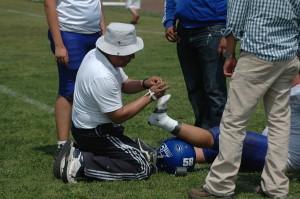Preventing Sports Injuries and Treating Them When They Do Occur
 Sports provide numerous benefits, from teamwork to dedication to improving fitness. They can also, however, be dangerous. It is important to understand how to protect yourself from the dangers of sports and how to prevent injuries. If injuries do occur, knowing how best to treat them is the key to a quick recovery.
Sports provide numerous benefits, from teamwork to dedication to improving fitness. They can also, however, be dangerous. It is important to understand how to protect yourself from the dangers of sports and how to prevent injuries. If injuries do occur, knowing how best to treat them is the key to a quick recovery.
Knee Injuries
Most sports can cause a knee injury if people aren’t careful. Stretching is one of the best ways to prevent this type of injury. Perform a quad stretch by grabbing your ankle and pull your leg behind your body. This will stretch out your knees and quadriceps. A simple toe touch will suffice as well.
An ACL injury is one of the most common injuries, often happening during games like soccer and football where legwork is important. A knee replacement surgery may the final option if rehabilitation and pain medication do not work. Look at total knee replacement pictures and you’ll see the difference between a knee that needs replacement and one that has been replaced.
Dislocations
Joint dislocation is common during sports. A dislocated shoulder is actually one of the most common boxing injuries to occur. To prevent it, be sure you keep your arms close together and do not make any wide or overly exaggerated swings.
Medical attention is necessary for this type of injury, as dislocations do not simply heal on their own. It can take at least three weeks to recover from treatment.
Hip Flexor Strains
Another common sports injury is a hip flexor strain. This happens a lot in runners and those who have to run a lot during a sport they play, such as football. Quick turns and sudden starts can be the culprits here, along with running on an incline. To prevent this type of problem, pay more attention to how you run and avoid starting or stopping quickly if at all possible.
It is usually recommended to ice the area and get plenty of rest to let it heal. If you push yourself through the pain with this injury, it could lead to requiring serious medical treatment. Surgery may even be necessary.
Concussions
Concussions are easy to achieve in contact sports. Any fall or bump to the head can lead to a concussion. Typical signs are headaches, dizziness, confusion, fatigue, light sensitivity, and nausea. If you experience any of these symptoms after hitting your head, it is best to be evaluated. It will require some serious rest and perhaps pain medication to eliminate the symptoms of this injury.
Pulled Groins
Athletes often pull their groins. The area between the upper-inner thigh and knee can be affected. Poor flexibility can be a cause, as well as quick movements from side to side. Improving your flexibility by doing stretches before your game or practice can be a huge help in preventing a groin pull.
Treatment often involves some light stretches of the muscles in the area and icing the location every 20 minutes for the first few days. After those few days, heat is typically recommended to further the healing process.
A variety of sporting activities can cause numerous injuries. Always practice prevention methods to stop these injuries from occurring. If they do occur, however, it is important to seek immediate treatment options. Start by trying ice, rest, pain medication, and home remedies to see if they will suffice before further options are needed.
I recently found much useful information in your website especially this blog page. Among the lots of comments on your articles. Thanks for sharing